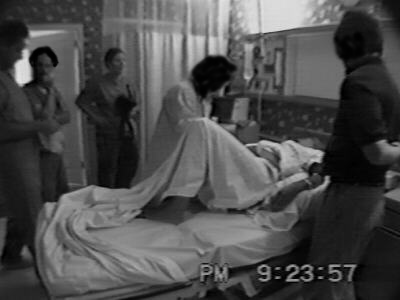Initial questions
In principle, some one or more aspects of who the parties and where/when they are talking may indispensably relevant for producing and grasping the talk, but these are not decisively knowable a priori. It is not for us know what about context is crucial, but to discover it, and to discover new sorts of such things.Let's say that any hospital labor can be approached as a scene within a play.
(Schegloff, 1991:66)
 This scene might be summarized briefly in terms of its actors (three men and
three women), dramatis personae, dramatic tension ("are the child and mother
going to be alright?"), and particular moments.
This scene might be summarized briefly in terms of its actors (three men and
three women), dramatis personae, dramatic tension ("are the child and mother
going to be alright?"), and particular moments.
In the images on the left, up to five actors play one of these moments when obstetrician and nurse prepare to give the woman in labor an internal examination while anesthesiologist, husband and researcher back off. Most people who have experienced the world of late 20th century medicine, directly as patients, or indirectly from the media, will recognize the play and the scene and not notice much that is surprising about it except perhaps for the presence of a researcher. This familiarity must be questioned: how can something like this be familiar?
And yet, this performance of the play is unique in many ways. This uniqueness must also be questioned: how "unique" can anyone who gives birth in an American hospital make any delivery?
These web pages dedicated to answering these questions have been designed to be read from at least three points of view:
- From the point of a relative novice in interactional analysis and cultural anthropology who can follow the main links and disregard the secondary links.
- From the point of view of a more expert reader who might want to explore secondary links discussing the theoretical justifications for the statements made in the main links.
- As an experiment in presenting research in interactional analysis using the new publishing tools available to researchers.
